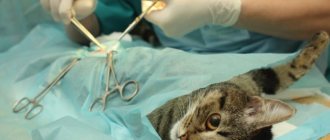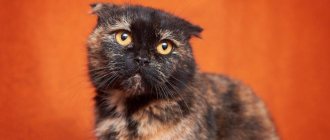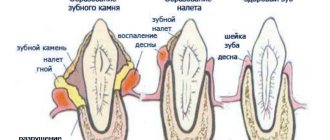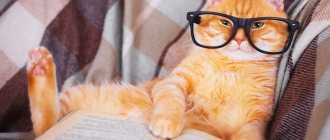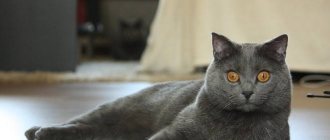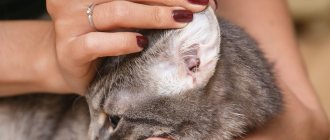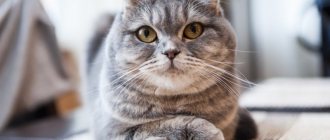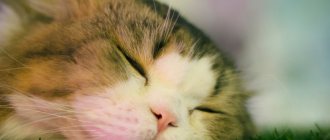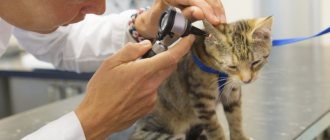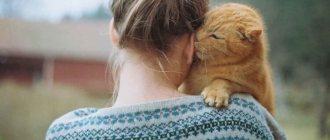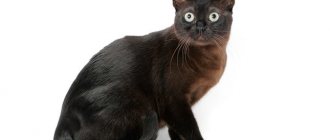Heart disease in an animal is always difficult to predict. Pets are not people; they cannot tell if they are experiencing chest pain. That's why so many mustachioed friends die from heart disease. Heart attacks in cats most often occur suddenly, so it is important for the owner to know what the symptoms and causes of this disease are, as well as how to treat it.
Veterinarians note that myocardial infarction is very rare in felines, but this does not diminish its health hazard. It is caused by the death of a section of the pet's heart muscle. This provokes severe dysfunction in the functioning of a vital organ. Without medical intervention, the animal will soon die.
Stress-induced feline cardiomyopathy
This form of cardiomyopathy develops in completely healthy cats after exposure to a stress factor. Most often this occurs within 1-30 days after planned surgical interventions (castration and sterilization). The disease is characterized by temporary thickening of the myocardium of the left ventricle, probably due to inflammation of the heart muscle, the relaxation processes of the heart are disrupted, which leads to the fact that the left ventricle is not able to pump out all the blood from the pulmonary circulation. The pressure in the pulmonary veins and left atrium increases and congestive heart failure develops, which manifests itself in the form of pulmonary edema or hydrothorax.
Prevention
Most preventive measures against this disease do not lead to any lasting effect. However, there is no need to completely abandon attempts to protect the animal from a heart attack. First of all, the owner must balance the cat's diet. Do not give him a lot of fatty foods, this will protect the blood vessels from the formation of cholesterol plaques in them. Never overfeed your cat with liver, cheese, or beef. In order to reduce the risk of blood clots, give your animal more fluids, this will prevent the blood from clotting too much.
If we talk about drug prevention, then taking sedatives, blood thinners and diuretics has proven itself to be good. Sometimes veterinarians prescribe cardiac stimulation sessions, which can significantly reduce the risk of a heart attack.
Recently, experts have found that a lack of the amino acid taurine in the body is largely to blame for the occurrence of heart failure. For this reason, today many dry foods add this vital compound to help reduce the incidence of heart disease in mustachioed pets.
Finally, I would like to add that preventive actions to prevent myocardial pathology are not so difficult to implement. Every owner who wants to see their animal healthy is obliged to take care of their implementation. It is much easier to stick to a diet and occasionally give the cat sedatives than to treat it after a heart attack has occurred.
Arterial thromboembolism in cats
Thromboembolism (formation of blood clots) and heart failure in cats are common diseases of the heart and blood vessels.
Thromboembolism occurs when blood clots form in one of the chambers of the heart and then break off and travel through the bloodstream. Eventually, these blood clots enter the blood vessel and can block its lumen.
Although a clot can occlude any vessel, the most common site for feline arterial thromboembolism is the terminal segment of the abdominal aorta, which supplies the hind legs.
This problem is called abdominal aortic thromboembolism. A blood clot in this area cuts off the blood supply to the hind legs. When this happens, the cat can no longer use its back legs properly and will drag its feet. This disease of the cardiovascular system is malignant and is characterized by high mortality.
First aid from the owner
The first thing to do if you suspect a heart attack is to call your veterinarian. According to the symptoms described by the owner, he will recommend giving the animal Corvalol or another drug.
IMPORTANT! You should not give any medications without a doctor’s instructions, otherwise your pet’s condition will only worsen!
What to do next:
- Provide the cat with complete rest - do not shift him or disturb him, do not make noise near him.
- The room in which the patient is located should be well ventilated; extreme heat and stuffiness should not be allowed.
- It is highly advisable to have a veterinarian come to your home. If this is not possible, ONLY use a carrier with a hard plastic bottom.
- Do not give water or food to the patient; if the veterinarian recommends any medications over the phone, give them strictly in liquid form or in the form of an injection.
Remember that you can’t help anything at home, so you definitely need to show the sick person to a specialist.
Congenital heart defects in cats
Congenital heart defects can also occur in cats. There are several types of birth defects that can be seen in feline cardiology.
Sometimes there is malformation (also known as dysplasia) of the heart valves.
Ventricular septal defects are essentially “holes” that occur between the two ventricles of the heart. These defects are sometimes diagnosed in cats.
Atrial septal defects and "holes" that occur between the two atria of the cat's heart rather than the ventricles can also occur.
Other rare defects include patent ductus arteriosus, aortic stenosis, and tetralogy of Fallot. Patent ductus arteriosus is an abnormal vessel connecting the aorta and pulmonary artery that causes blood to bypass the heart. Aortic stenosis is a narrowing of the large vessel known as the aorta, which leaves the left ventricle of the heart and carries blood to the rest of the body. Tetralogy of Fallot is a combination of four separate developmental defects in the heart.
Diagnostics in a veterinary clinic
Due to the fact that signs of the disease go unnoticed or the owner reacts late to signs of pain, the pet does not always have time to get help in a timely manner. In severe cases, he dies immediately. You should not hesitate to contact a specialist at the slightest suspicion of a serious case. By seeing the symptoms and having a short conversation with the owner, the veterinarian can make an initial diagnosis.
The next step will be to differentiate a cat’s heart attack from other cardiovascular diseases that have similar symptoms: myocarditis, pericarditis, pancarditis, cardiomyopathy. The doctor will also check the patient for brain pathologies. Instrumental methods such as echocardiography, electrocardiography, and ultrasound help to study impaired functions. The latter analysis accurately determines the presence of malfunctions in the left or right ventricle.
For diagnostic purposes, a general blood test and biochemistry are performed. This allows us to detect leukocytosis (increased white blood cell count), increased erythrocyte sedimentation rate (ESR), changes in the level of phosphatase, amylase, creatinine, and heart enzymes.
Myocardial infarction and coronary syndrome in cats
Myocardial infarctions similar to those in human patients do not occur in cats. Microscopic myocardial infarctions are common in cats. This problem occurs in any form of cardiovascular disease. Such processes are the cause of the formation of “burn-out” cardiomyopathy in cats. This heart disease can be considered as a transformation of the HCM phenotype into DCM.
Identifying and analyzing signs of heart disease in cats is a complex process. Correct diagnosis of the cause of heart disease is necessary to determine the correct course of treatment, as well as determine the prognosis and management of a sick cat.
In the veterinary city of Serpukhov, the appointment is conducted by cardiologist Andrey Anatolyevich Rudenko. Our clinic has a full range of diagnostic equipment to determine the nosological form of heart disease in your domestic cat.
Treatment for a pet who has had a heart attack
The very first thing that the owner of a cat who has suffered a heart attack must understand is that the treatment must be completely carried out by a veterinarian. It is unacceptable to try to treat an animal yourself, especially with drugs that are intended for humans. Be sure to follow the medication regimen prescribed by your doctor. Do not change the dosage or rely on the opinions of people whose animals have experienced something similar. It is important to realize that each case is individual.
The beginning of therapy involves taking a drug such as Nitroglycerin or its closest analogues. In addition, the specialist also prescribes anticoagulants that prevent the animal from developing blood clots. The veterinarian must prescribe a diet suitable for the cat’s condition. It should consist of food that is easily digested and absorbed by the stomach. Of animal proteins, it is permissible to include only fermented milk products in the diet, but not particularly fatty ones.
A cat who has had a heart attack is given a saline drip to avoid dehydration. In conjunction with this, injectable solutions of saline and glucose are also recommended, which are administered one at a time. Of the medications in tablets, the doctor prescribes to the patient those that have a mild sedative effect and are able to support a depleted heart.
Rest is the key to a quick recovery for a mustachioed friend who has suffered a myocardial infarction. The owner must protect it from excessive loads and noise. If there are children in the family, then you need to ask them not to play with the animal for a while and not disturb it without doing anything. Failure to follow these simple recommendations can contribute to a rapid relapse of the disease. The chances of surviving a second heart attack for any individual are zero.
Due to the fact that necrosis of the myocardium has already occurred, one should not hope for an absolute recovery. A scar formed on the heart muscle will prevent its normal contraction. Remember that the health of the nervous system and the absence of shocks will help the cat live a long and fulfilling life.
Diagnosis and treatment
Diagnosis is carried out by examining the animal and conducting additional ECG and EchoEG studies.
To treat a sick animal, several groups of drugs are used (aimed at relieving pain and improving heart function):
- antiplatelet agents;
- antiarrhythmetics;
- antispasmodics;
- and other groups of medications at the discretion of the doctor.
The animal is recommended to have a light diet consisting of easily digestible foods (carbohydrates, proteins, fermented milk products). Fatty meats should be excluded. The pet needs peace, care and care.
What symptoms indicate a heart attack?
A sign of impending cardiac pathology is the dilation of your pet’s pupils.
The symptoms of the disease are directly related to the period of occurrence of the pathology. The first signs develop in the subacute and acute stages. The following are the symptoms of a heart attack in cats:
- pain syndrome in the left limb, due to which the animal begins to limp;
- dyspnea;
- excitability of the cat;
- dilated pupils;
- loss of appetite;
- heart rhythm disturbances and rapid pulse;
- change in the shade of the mucous membranes to blue;
- lack of coordination.
A heart attack in cats usually has a sudden onset, but sometimes the owner may notice signs of pathology 2-3 days before the attack. Symptoms can be pronounced or sluggish. At the same time, it is important for the owner to pay attention to any changes in the pet’s condition and behavior. If he is initially excited and then rather weakened, this should alert the person. In such a situation, veterinarians recommend taking the animal to a medical facility as quickly as possible. It is important not to give him any medications, as this can cause serious complications for the body.
Treatment prescribed by a veterinarian
The veterinarian begins urgent measures to prevent an attack and its consequences immediately after an accurate diagnosis. Drug therapy for heart attacks in cats is prescribed only by a specialist. Self-medication is unacceptable, because it can have a bad effect on the general condition of your mustachioed friend.
First of all, medications are prescribed to relieve pain. Painkillers such as Ketofen and Ketonal are popular in veterinary medicine.
In case of diagnosed illness, the following are used:
- drugs against blood clot formation - Heparin and Warfarin;
- sedatives, sedatives - Kot Bayutn, Fospasim, Fitex;
- diuretics that help remove swelling and reduce the load on organs - Furosemide, Veroshpiron;
- adrenaline beta blockers, which increase myocardial function - they supply oxygen and help increase metabolic processes - Atenolol, Metoprolol, Propranolol;
- complexes of vitamins C, B5, B6, B12.
At any stage of a heart attack in cats, a drip with a water-salt solution is used to help protect the body from dangerous dehydration. For this purpose, injections are given from saline or glucose solution, doing them in turn.
Severe pain syndrome rarely goes away on its own, and without adequate medical care the patient almost always dies. If the use of analgesics was timely, the discomfort in the sternum will disappear in a couple of minutes.
Symptoms of heart problems
How can you even understand that your pet has some kind of heart problem?
The problem is that cats are notorious couch potatoes. And if “problems” in the behavior of the same dogs quickly become obvious during regular walks, a cat’s illness can remain completely unnoticed for a long time. However, you may notice that your pet has become more “lazy” and tries not to move unless absolutely necessary. If the cat “deigns” to walk to the bowl, it is not difficult to notice that such a simple action was not easy for him: the animal begins to choke, wheeze and cough.
It is no coincidence that veterinarians consider early diagnosis of heart pathologies in cats to be a difficult and thankless task. Often there are no clinical signs at all. Until the pet’s body passes some “critical point”, after which the symptoms begin to increase exponentially.
As for the characteristic signs of cardiac pathologies, these include:
- difficulty breathing; wheezing;
- severe shortness of breath that occurs even after light physical exertion;
- in severe cases (even without a phonendoscope), you can hear something gurgling and bubbling noisily in your pet’s chest. These are very alarming signs indicating the presence of profuse effusion in the chest cavity. The fluid compresses the lungs and heart, causing all the breathing problems described above to develop;
- severe hypothermia of the limbs and other parts of the body (for example, ears and paws);
- paleness of all visible mucous membranes (gums and eyes). All this indicates a serious deterioration in blood circulation in the animal’s body;
- in severe cases (often when the cat is already dying), the skin over the entire surface of the body becomes cold.
Note that coughing with heart disease is not typical for cats. This sign is more often observed in sick dogs. It is highly likely that in cases where your cat is coughing uncontrollably and panting heavily, the heart has nothing to do with it. Most likely, we are talking about bronchitis or other lung diseases.
Major heart diseases
Depending on the area of damage, the following diseases are distinguished:
- Pathologies of the heart muscle (myocardium).
- Problems with the heart valve (defect).
- Arrhythmia is an abnormal heart rhythm.
- Endocarditis is inflammation of the endocardium, the inner lining of the heart muscle. The cause of the disease is a bacterial infection that damages myocardial tissue, causing erosions. Complications – valve deformation, heart failure, abscess of internal organs.
- Pericarditis is an inflammation of the serous membrane of the myocardium, when the volume of fluid increases in it, complicating the work of the myocardium. The pathology occurs in cats, middle-aged and elderly dogs. Causes include infection, acute allergies, penetrating chest injuries, sepsis, and tumors.
Constriction of blood vessels leads to increased blood pressure. This increases the load on the heart, which, when pumping, is forced to exert greater force so that the blood can reach all parts of the body. The result is premature wear of the myocardium.
A separate group can be divided into a heart attack, the causes of which are stenosis (persistent narrowing of veins and arteries) or blockage of a coronary vessel by a thrombus. If it is partially blocked, blood can flow, the animal will survive, although it will suffer. If the blockage is complete, the pet will most likely die.
How the heart works
The heart is a pump that pushes blood around the body. The arteries carry plasma containing the nutrients and oxygen needed by every cell in the body. The blood transfers them to tissues, takes away toxins, carbon dioxide and other breakdown products. It becomes dark in color and carries the poison through the veins to the organs that carry the poison out - to the lungs, liver, kidneys.
In mammals, the heart is complex. It consists of 2 atria, 2 ventricles, valves separating them, and the rhythm is set by electricity. It works according to this scheme:
- Blood with carbon dioxide enters the right atrium, from there into the right ventricle and lungs.
- Here it is purified, gives off carbon dioxide, receives oxygen and passes into the left atrium, then into the ventricle.
- Before releasing blood into the body, the left ventricle contracts. Then the valve opens and the heart forcefully pumps blood into the aorta, the largest vessel in the body.
- Further, the plasma is distributed through smaller arteries and, through capillaries, transfers beneficial substances to tissues and removes toxins.
Symptoms of the disease
The main symptoms characteristic of a heart attack in cats:
- pain in the left paw in the elbow area, manifested in lameness;
- painful chest;
- a state of anxiety, excitement, often accompanied by meowing;
- pallor, cyanosis of mucous membranes and skin;
- dyspnea;
- dilated pupils;
- severe weakness that replaces excitement;
- lack of appetite;
- poor coordination of movements, unsteady gait;
- presence of arrhythmia;
- increased heart rate.
All of the above symptoms may be present at the same time. However, the presence of only some of them cannot be ruled out.
Symptoms: When should you worry?
Not all cats are prone to coronary heart disease.
Most often, it affects cats that lead a sedentary lifestyle and love to eat a lot. Therefore, even if the cat lives in an apartment with little space, you need to play with it a lot so that it develops physically. Forays outside will also be useful.
You also shouldn't keep your cat stressed all the time. Animals really don’t like changing homes or owners. For them, just like for people, losing a loved one or furry friend is scary.
Prevention of cardiovascular diseases in pets
- If your pet is at risk, upon reaching the age of 5, take him to a cardiologist once a year and have an electrocardiogram done.
- See a doctor if your animal's breathing becomes faster after slight exercise or at rest. Pay attention to other symptoms of heart failure - most notably, increased fatigue.
- Get vaccinated regularly.
- Give deworming medication once a quarter. Dirofilariasis (heartworm) is a deadly disease that is very common in dogs.
- Don't yell at your pet or family.
- Place your dog's or cat's sleeping place away from heating appliances.
- Do not overload your pet, avoid too intense exercise.
- Do not give food from the table, especially fatty, fried, peppered, rich in seasonings.
What should a cat's diet be?
- Industrial feed should not be of the mass market class (Kitekat, Whiskas, Felix and others). You should switch your cat to premium food (Hill's, Royal Canin, Purina Pro Plan and others) sold in veterinary pharmacies. They will be useful not only for the cat’s heart, but also for her entire body. Even dry food is unlikely to give your pet urolithiasis, the development of which is caused by cheap dry food.
- No matter how compassionate a cat’s eyes may be, you should never give her treats from the master’s table. It is especially worth excluding pork, lard, fried meat and fish from the diet of your favorite animal.
- Baby food is good for feeding.

